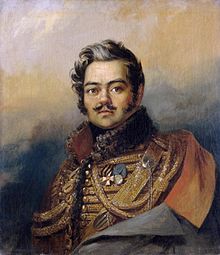
(1784-1839)
Russian cavalry commander and guerrilla leader.
Denis Vasilievich Davydov was born to a prominent Russian noble family and enlisted as an estandart junker (officer candidate or cadet) in the Chevalier Guard Regiment on 10 October 1801, rising to cornet on 21 September 1802 and to lieutenant on 14 November 1803. For writing satires about his superiors, Davydov was transferred to the Byelorussia Hussar Regiment on 25 September 1804, and then, on 16 July 1806, he joined the Leib Hussar (Life Guard Hussar) Regiment with the rank of lieutenant. On 15 January 1807 he was appointed an adjutant to Prince Peter Bagration and rose to staff rotmistr (a rank in the Guards, equivalent to major in the regular forces of the Army) on 26 January 1807. During the campaign in Poland, he served in Bagration’s detachment, participating in numerous rearguard actions as well as in the major battles of Eylau (for which he garnered a golden cross), Güttstadt, Heilsberg, and Friedland. For his actions he was decorated with the Order of St. Anna (2nd class) and the Prussian Pour le Mérite.
From February to April 1808, during the Russo- Swedish War, Davydov again served under Bagration in Finland and then joined General Jacob Kulnev’s advance guard, fighting at Sikaioki, Karloe, Lappo, Perho, Kuhalambi, Kuortain, Salmi, Oravais, and Gamle-Kamlebi. In April 1809 he took part in Bagration’s expedition to the Åland Islands. In July 1809 he followed Bagration to the Danubian Principalities, where Davydov fought against the Turks at Macin, Girsov, Rassevat, Silistra, Tataritsa, and Shumla (for which he received the Order of St. Anna [2nd class]). Promoted to rotmistr of the Leib Hussar Regiment on 16 March 1810, he transferred as a lieutenant colonel to the Akhtyrsk Hussar Regiment on 20 April 1812.
During the 1812 campaign, Davydov served in the 14th Brigade of the 4th Cavalry Division in the 7th Corps of the 2nd Western Army and participated in the battles at Romanovo, Saltanovka (Mogilev), and Smolensk. Following the battle at Smolensk, Davydov organized, with Bagration’s consent, a guerrilla detachment to harass the French communication and supply lines. He distinguished himself at Lyakhov, where his troops captured an entire French brigade from General Pierre-François-Charles Augereau’s corps. He then fought at Vyazma, Krasnyi, Kopys (for which he received the Order of St. George [4th class]), Shklov, Starosel, and Grodno. For his actions in 1812 Davydov was promoted to colonel and awarded the Order of St. Vladimir (3rd class).
In 1813 Davydov commanded a detachment in General Ferdinand Winzegorode’s forces at Kalisch and later made a daring raid on Dresden, capturing Neustadt in March. However, he acted without orders during this operation, for which he was relieved of command and transferred to Major General Sergey Lanskoy’s detachment. He then took part in the actions at Predel, Ezdorf, Ubigau, Bautzen, Dresden, Reichenbach, Zeitz, Altenburg, Chemnitz, Naumburg, and Leipzig, as well as in the pursuit of the French army to the Rhine. For his actions in 1813 he received an imperial letter of gratitude. The following year Davydov commanded the Akhtyrsk Hussar Regiment in France, distinguishing himself at Brienne, La Rothiere (where he was promoted to a major general on 2 January 1816 with seniority dating from 1 February 1814), Montmirail, Chateau-Thierry, Laon, La-Fere-Champenoise, Craonne, and Paris.
Returning to Russia, Davydov served as an assistant to the commander of the 1st Dragoon Division (2 January 1815) and then in the same capacity in the 2nd Horse Jäger Division (26 March 1816) and the 2nd Hussar Division (3 June 1816). On 19 November 1817 he took command of the 1st Brigade of the 2nd Hussar Division. On 3 March 1818, he became the chief of staff for the 7th Infantry Corps and, on 6 March 1819, for the 3rd Infantry Corps. He was relieved of command on 29 March 1820 and retired because of illness on 26 November 1823, but he returned to the army on 4 April 1826. Davydov participated in the Russo-Persian War in 1826, fighting at Amymly and Alagez, and he constructed the fortress of Djelal-Oghlu. However, his health quickly deteriorated, and he had to take an extended furlough to recuperate in 1827. Four years later, he returned to the army during the Polish uprising, taking command of a cavalry detachment of one dragoon and three Cossack regiments. He captured the town of Vladimir (Volhynia) on 18 April 1831. He then commanded the advance guard in General Fedor Ridiger’s corps, earning his promotion to lieutenant general on 18 October 1831 and the Orders of St. Anna (1st class) and of St. Vladimir (2nd class).
After the campaign Davydov returned to his estate of Verkhnaya Maza in the Simbirsk gubernia (province), where he died on 4 May 1839. Before his death, he organized the transfer of Bagration’s remains from the village of Simy for reinterment on the Borodino battlefield, where he had received his mortal wound.
Davydov left a diverse literary legacy. In addition to numerous poems and lyrics, he wrote articles and memoirs that remain important sources for the study of the Napoleonic Wars. They contain vivid and insightful accounts of the military actions and interesting characterizations of the prominent Russian commanders.
References and further reading Davidov, Denis. 1999. In the Service of the Tsar against Napoleon: The Memoirs of Denis Davidov, 1806-1814. Trans. Greg Troubetskoy. London: Greenhill. Mamishev, V. 1904. Gen. lieutenant D. V. Davydov. St. Petersburg: N. p. Serebryakov, G. 1985. Denis Davidov. Moscow: Molodaia gvardiia.